Abstract
Ancient thinking conceived Temperance as the enemy of pleasures and excesses, mainly bodily pleasures. This idea was the source of Temperance’s depictions in the Middle Ages. Attributes such as the torch and jug, castle, tower, bit, salamander, ermine, or the presence of Cupid accompany Temperance’s personification as controlling elements of bodily pleasures. The combinations of attributes relative to chastity give rise to two different iconographic types. These iconographic types translate theoretical considerations about this virtue visually.
1. Introduction
Although there were no visual references in Antiquity, representations of Temperance appeared in the Middle Ages. Its first depictions are from the 9th century, and how it is represented led to several iconographic types.1 León Coloma (1998) approached some of these iconographic types. However, scholars paid more attention to Temperance’s “new visuality”2 iconographic type (Whitehead 1960; White 1969, 1973; North 1979) because of technological innovation of its attributes. Other research about Temperance’s visualization usually focuses on a concrete work of art, such as Camelliti’s (2013) essay. Art historians usually try to explain allegories using Cesare Ripa’s Iconologia (1593; Ripa 1765), but in this case, we do not find medieval Temperance depictions in this treatise or similar treatises. Broad research about Temperance’s image is necessary, so this essay focuses on visual depictions of chastity in Temperance’s depictions. As a result, several attributes and iconographic types emphasize the quality of chastity in temperance as a virtue. This essay exposes the origin of these attributes by drawing attention to their meaning. This research merges art history and written sources with an iconographical approach3 by relating images to written sources. With this purpose, this essay’s structure has three parts. The first section briefly explains a theoretical framework from classical and medieval written sources as an introduction to the topic. The second part exposes the origin, continuity, and variation of “Chaste Temperance” iconographic types in which chastity makes sense for their characteristic attributes. The third section explains other Temperance attributes related to chastity, such as a bit, bridles, salamander, and ermine.
2. Chastity as a Virtue Associated with Temperance
Soprhosyne referred to Temperance in the classic Antiquity, which meant self-control and chastity, among other meanings (see North 1979; Rademaker 2004). Some literary and philosophical sources define this term. Plato defined temperance as “an order and control of pleasures and lust” (Plato 1949, p. 81; R. 8, 430e).4 Aristotle explained that “To sobriety of mind it belongs not to value highly bodily pleasures and enjoyments, not to be covetous of every enjoyable pleasure” (Aristotle 1868–1944, p. 60; VV 2, 1250a 5). According to Aristotle, Virtue is at the midpoint between two extremes, which are two vices (Arist. EE, II, 3, 5, 10), placing temperance between lust and chastity: “Temperance is a midpoint between licentiousness and lack of sensitivity about pleasures” (Aristotle 1973, pp. 1330–31; MM 21, 1191a).5
Temperance’s opposition to lust prevailed because Apuleius mentioned Moderation—one of Temperance’s qualities—when Venus was outraged by her son. She threatened to appeal to Temperance to extinguish Cupid’s fire in lovers’ hearts:
“Dare I ask for helps from my enemy Moderation, whom my son’s very excesses so often offend? Yet shudder at the thought of tackling that squalid old peasant woman. Still, whatever its source, the solace of revenge is not to be spurned. I must certainly use her, her alone, to impose the harshest punishment on that good-for-nothing, shatter his quiver and blunt his arrows, unstring his bow, and quench his torch”.(Apuleius 1996, p. 170; Met. V,30,5)6
Also, in Ovid’s Metamorphosis (X, 143–153) fire represents lust: “Now there is gentler work for the lyre, and I sing of boys loved by the gods, and girls stricken with forbidden fires, deserving punishment for their lust”.7 Fire symbolizes the passion in most of Sappho’s poetry and means triumphant love (North 1979, p. 180). So, sophrosyne personifies Cupid’s enemy, whose soul it tries to extinguish. The enmity between bodily pleasure and Temperance remained, as demonstrated when Macrobius explains that Temperance is “to abstain from everything that the habits of the body seek”.8
Although Aristotle opposed Temperance to lust and chastity, the last one became one of Temperance’s virtues. Thinkers have considered that Cardinal Virtues were composed of other virtues. Macrobius explains: “Temperance is accompanied by modesty, humility, self-restraint, chastity, integrity, moderation, frugality, sobriety, and purity”.9 This idea remained in medieval thought, in which chastity and purity are Temperance’s virtues, as Alain de Lille in De Virtutibus et de Vitiis et de Donis Spiritus Sancti (11th century)10 and Bono Giamponi in Il libro de’ vizî e delle virtudi e Il trattato di virtú e di vizî (ca. 1264)11 explain. Hugh of St. Victor gave seven leaves to Temperance’s branch in his tree of Virtues, and “afflictio carnis”12 was one of them. Aquinas considered chastity and virginity as Temperance’s virtues (S.Th. [45040] IIª-IIae, q. 152) and opposed Temperance to lust.13 For these reasons, Bono Giamboni’s Il libro de’ vizî e delle virtudi e Il trattato di virtú e di vizî14 and William Langland’s Piers Plowman (1370–1386, passus XIX)15 explained Temperance’s function to control passions and wishes. So, ancient thinking continued in the Middle Ages, as many thinkers explain.16 These theoretical considerations were translated visually in Temperance images, and some emphasized chastity as one of its qualities.
3. “Chaste Temperance” Iconographic Types
Temperance’s images came up during the Middle Ages, when two different iconographic types of “Chaste Temperance” appeared. We can distinguish between the two iconographic types because Temperance holds distinct attributes, but both have the same purpose: highlighting chastity in Temperance images.
3.1. Chaste Temperance 1: Fire and Water
“Chaste Temperance 1” appeared in the 9th century and was codified from classical sources and Aurelius Prudentius’s work. The main attributes of this iconographic type are the torch and the pitcher or container, which refer to how Chastity defeats Lust. In Cambrai Gospels (9th century, Cambrai, Municipal Library, ms. 327, fol. 16v) and Marmoutier or Autun Sacramentary (ca. 845–850, Autun, Municipal Library, S 019, fol. 173v) (Figure 1), Temperance holds a torch and pours water with a pitcher. These attributes remind us of patristic sources. Julianus Pomerius explains that the main activity of Temperance is extinguishing the passion’s fire: “Ignem libidinosae voluptatis extinguit” (Pomer. De vita contemplativa, 3, 19; PL LIX, 502). So, these attributes refer to extinguishing concupiscence fire, as in Antiquity was Venus and Cupid’s enemy.
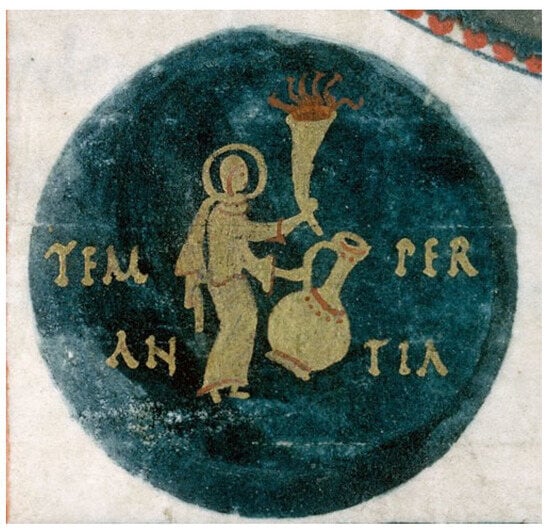
Figure 1.
Temperance, Marmoutier or Autun Sacramentary, ca. 845–850, Autun, Municipal Library, S 019, fol. 173v.
However, Temperance’s literary image17 appeared in Antiquity. Prudentius’ Psychomachia (4th century) developed Tertullian’s idea of a battle between the Christian Virtues and the Vices. This epic poem is crowded with combats similar to Illiad (Lackey 2005, p. 563) or Aeneid (O’Reilly 1988, p. 13). Concretely, a “psychomachia” is the constant soul’s (Psyche) combat, an interior fight between spirit and flesh. Prudentius’ poem consists of seven battles between personified Vices and Virtues and concludes with a successful battle to build the Wisdom temple to celebrate the soul’s triumph. One of these Psychomachia’s fights is between Libido (Lust) and Pudicitia (Chastity):
“Next to step forth ready to engage on the grassy field is the maiden Chastity, shining in beauteous armour. On her falls Lust the Sodomite, girt with the fire-brands of her country, and thrusts into her face a torch of pinewood blazing murkily with pitch and burning sulphur, attacking her modest eyes with the flames and seeking to cover them with the foul smoke”.(Prudentius 1949, p. 283; PL LX, 19, 40–45)
The depictions of this fight show Chastity as a soldier holding some spears and Lust holding three torches on fire, as in Psychomachia (ca. 900–1049, Brussels, Bibliothèque Royale de Belgique, ms. 10066-77, fol. 116r) (Figure 2a). So, extinguishing Lust’s fire was depicted in Temperance’s image. The torch is an emblem of Lust—Temperance’s enemy vice—and Temperance tries to put out with its pitcher. Erwin Panofsky explains:
“To mediaeval mind, thoroughly familiar with such authors as Seneca and Horace, the torch appeared as a symbol of unholy ardor even more telling than the bow and he arrows—so that the illustrators of Prudentius’ Psychomachia, where only bow and arrows are mentioned as the attributes of Cupid, were prone to supplement them by the torch which in the text belongs to his mistress, Libido”.(Panofsky 1965, p. 94)

Figure 2.
(a) Chastity vs. Lust, Psychomachia, ca. 900–1049, Brussels, Bibliothèque Royale de Belgique, ms. 10066-77, fol. 116r. (b) Lust defeated by Chastity, Psychomachia, ca. 900–920, Stadtbibliothek Bern, ms. 264, fol. 36v.
In classical Antiquity, Temperance had to extinguish the passionate fire, and Prudentius’ Psychomachia Chastity defeats Lust,18 who falls with its torches (ca. 900–920, Stadtbibliothek Bern, ms. 264, fol. 36v) (Figure 2b). Then, “So spake Chastity, and rejoicing in the death of Lust, whom she had slain, washed her stained sword in the waters of Jordan; for a red dew of gore had clung to it and befouled the bright steel from the wound” (Prudentius 1949, p. 289; PL LX, 19, 98–104). Psychomachia’s manuscripts (10th century, Brussels, Bibliothèque Royale de Belgique, ms. 9987-91, fol. 102r) (Figure 3) show this image, which depicts when Chastity washes its sword in the Jordan River. Water to purify Lust’s fire is also depicted in Temperance’s image. Prudentius’s Psychomachia was the main source of inspiration for depictions of virtues during the Middle Ages. For images of Temperance, Psychomachia was essential for its first depictions because there were no direct visual precedents from classical sources,19 only written sources. In addition, until Aquinas organized Virtues between Cardinals and Theological in the 13th century, it was common to represent Cardinal Virtues by one of the virtues that compose them. In this case, chastity is one of the characteristic virtues of Temperance, so it is comprehensible that Chastity’s depiction in Psychomachia’s manuscripts was the artists’ inspiration to depict Temperance.
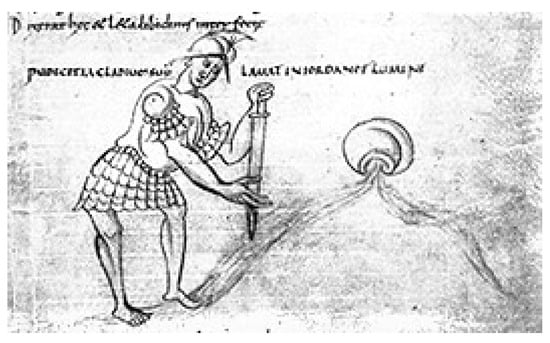
Figure 3.
Chastity washes its sword in the Jordan River, Psychomachia, 10th century, Brussels, Bibliothèque Royale de Belgique, ms. 9987-91, fol. 102r.
Beyond manuscripts, in Canterbury Cathedral (12th century) (Figure 4a), Temperance also holds a torch and a container to extinguish the fire. Although scholars locate the torch and pitcher as Temperance’s attributes during the 9th and 11th centuries, there are later artworks with them, like in a 14th-century manuscript (1308, London, British Library, ms. 83 II) (Figure 4b). Therefore, the iconographic type of “Chaste Temperance 1” appeared in the 9th century and was codified from classical sources and Prudentius’s work. The main attributes of this iconographic type are the torch and the pitcher or container, which refer to how Chastity defeats Lust. This image remained until the 14th century, when a new one appeared.
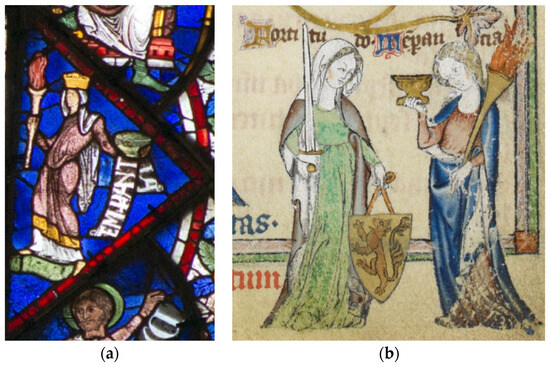
Figure 4.
(a) Temperance, 12th century, Canterbury Cathedral. (b) Fortitude and Temperance, Psalter of Robert de Lisle, 1308, London, British Library, ms. 83 II.
However, this idea remained in Temperance’s depictions through other attributes. Cesare Ripa’s Iconologia explains Temperance’s allegory as a woman who carries “Nella destra mano terrà una tenaglia con un ferro infocato, en ella sinistra un vaso di acqua, nel quale tempra quel ferro ardente” (Ripa 1765, 5, p. 268). So, fire is the emblem of love, which Cupid spread around the world. For this reason, Ripa thought “Forza di Amore” as Cupid—winged, holding a bow and arrows—who is under raining fire, referring to his power to burn down the world (Ripa 1765, 3, p. 119). Also, Boissard’s emblem “Ardenter et caste” shows an urn surrounded by flames, which refers to Chastity, which cannot be burnt by Lust’s fire (Boissard 1588, p. 72).
3.2. Chaste Temperance 2: Castle and Keys
Temperance’s chastity was emphasized again with a new depiction in the 14th century: “Chaste Temperance 2”. In this case, Temperance holds a castle and one or more keys. La Canzone delle Virtu e delle Scienze by Bartolomeo di Bartoli (ca. 1349, Chantilly, Musée Condé, ms. 599, fol. 3) (Figure 5) shows Temperance locking a tower with a key. Some leaves with inscriptions of Temperance’s virtues arose from this tower. A text (vv. 106–126) completes the depiction:
“La terza donna che’l nostro apetito/ch’ha’l soperchio dexio, domma e refrena,/sempre è d’onestà piena/e volser al suo chastel discreta chiave:/abre e serra soave,/cum vol razone a la cupiditate,/et in sobrietate/s’aviva, con fa’l corpo in nui per l’alma/e de vertù gran palma/produce e fructo bon suo dolce lito:/e poi chi vol nel sito/esser d’amore amante, chostei’l mena/a la sua real cena,/ma d’ogne vanitate e parlar brave/prima ch’i’ va, se vale./Ch’ivi è pur zente de benignitate,/sì ch’onne dignitate/a lor s’avean, però pun giù la salma/d’ogni viltà che scalma/in l’inferno Epichuro, che non volse/viver modesto e mo’ sotto lei dolse”.(di Bartoli 1904, p. 29)
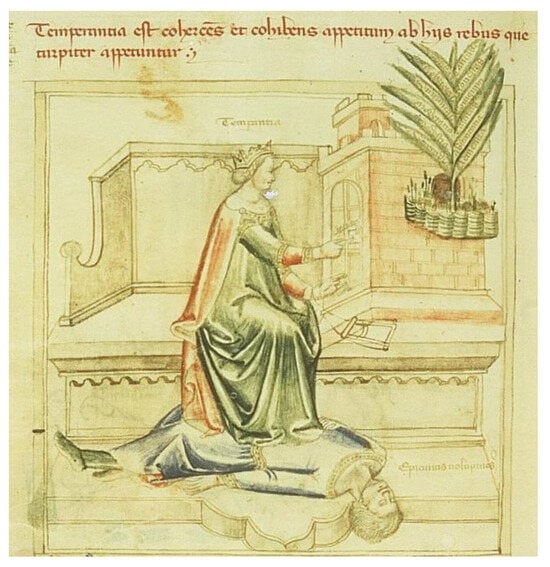
Figure 5.
Temperance, La Canzone delle Virtu e delle Scienze, Bartolomeo di Bartoli, ca. 1349, Chantilly, Musée Condé, ms. 599, fol. 3.
This image is related to the Song of Songs: “If she is a wall, we will build towers of silver on her. If she is a door, we will enclose her with panels of cedar. (She) I am a wall, and my breasts are like towers” (8: 9–10). So, this castle or tower represents the woman’s body, which has to be closed to protect her chastity and purity. There is a similar image in Virtues and Arts by Nicolò da Bologna (14th century, Novella super libros Decratalium, Giovanni da Andrea, Milan, Biblioteca Ambrosiana, ms. B. 42 inf., fol. 1) (Figure 6). In this case, Temperance has a small fortress on its knees and is going to open or close it with a key. Also, in the Salone delle Allegorie delle Virtù e dei Vizi from the Casa Minerbi-Del Sale in Ferrara (1360–1370), Stefano da Ferrara depicted Temperance opening or closing a castle with a key20 (Figure 7a). During the Middle Ages, the castle and key were an emblem of a man’s honor and the safekeeping of women’s chastity (Timoneda 1992, pp. 29–31). For this reason, Temperance’s image reinforces the idea of fighting lust, as Flor de Virtudes (14th century) explains: “La segunda es forçar la voluntad natural que viene por algún movimiento sensual, como aquellos que naturalmente son inclinados a luxuria, o gula o sobervia o ira o otros vicios a los quales se mueven por inclinación natural o por mal costumbre; e esta se llama sufrimiento. E esta es mayor virtud que la temperancia” (Hurus 2013, p. 111). The Aquinas’ Triumph by Andrea Bonaiuti (1366–1367, Florencia, Santa María Novella, Capilla de los Españoles) and a 14th-century manuscript (ca. 1340, Viena, Österreichische Nationalbibliothek, cod. ser. nov. 2639 fol. 1v) (Figure 7b) show similar images. Although the castle and keys were the most frequent attributes of this iconographic type, sometimes there is a variation: Temperance stands on defeated Epicure (figs. 5, 6 y 7b).21 Epicure is an exemplum of Lust, the enemy vice of Temperance, which it defeats in Prudentius’ Psychomachia.
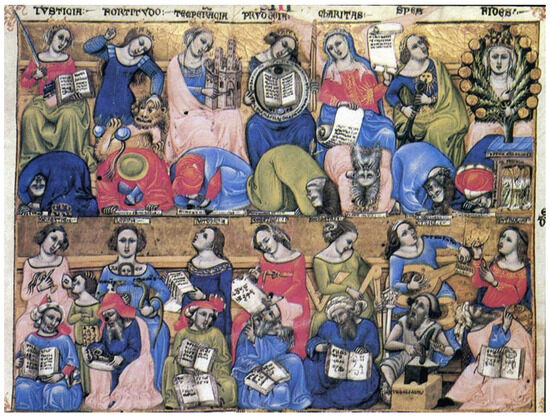
Figure 6.
Virtues and Arts, Novella super libros Decratalium, Giovanni da Andrea, 14th century, Milan, Biblioteca Ambrosiana, ms. B. 42 inf., fol. 1.

Figure 7.
(a) Temperance, Salone delle Allegorie delle Virtù e dei Vizi, 1360–1370, Ferrara, Casa Minerbi-del Sale. (b) Temperance and Prudence, ca. 1340, Viena, Österreichische Nationalbibliothek, cod. ser. nov. 2639 fol. 1v.
These ideas and images remained in the 15th century because, as Francisco de Imperial’s El decir a las siete virtudes (ca. 1407) explains about Temperance, “e la setena dos llaves doradas, para çerrar e abrir muy aparejadas, tenía en mano, en la otra un castillo” (Imperial 1977, p. 107). Imperial describes the other Virtues with traditional attributes, but Temperance’s attributes are less common: “La de senblante nin alegre nin triste,/que abre e çierra tan mansamente/el su castillo, segunt ver podiste,/es la Tenplança verdaderamente; su fija es Continençia propiamente,/e Castidat, Linpieza e Sobriedat,/Verguença, Templamiento e Onestat,/e Humildat, que el mundo non syente” (Imperial 1977, p. 112). Imperial’s work is only an example of this verbal image in the literature, but there are many more examples. Fernán Pérez de Guzmán wrote “ella lo conserve so secreta llave:/porque poco vale ganar si guardar” (quoted in Cacho 1999, p. 197). This quote emphasizes the importance of keeping chastity well protected because its corruption would cause it to lose its value. On the other hand, Pedro Manuel de Urrea combined the image of closing with a key and the necessity to turn off fire with water, comparing the human body to a boiling pot: “Razón es que yo le alabe/que encerrome y no paresco/y quando allí me amortesco/viene abrirme con su llave/Echame agua muy suave/que siempre brolla/madre herviendo esta mi olla” (quoted in Lacarra 1999, p. 167).
So, Temperance’s virtues are the meaning of the new attributes. Beyond literature, Antonio de la Sale’s work (1461, La Haya, Koninklijke Bibliotheek, ms. 9287–9288, fol. 113) (Figure 8) is proof of the continuity of this iconographic type during the 15th century. In the next century, there is some reference to the key, as La Perriére explains: “Que femme honneste aller ne doibt pas loing/le doigt levé, qu’à parler ne s’avance./La clef en main, denote qu’avoir soing/doibt sur les biens du mary, par prudence” (de la Perrière 1545, emb. 18). Therefore, the key is the main object of Temperance’s chastity safekeeping.
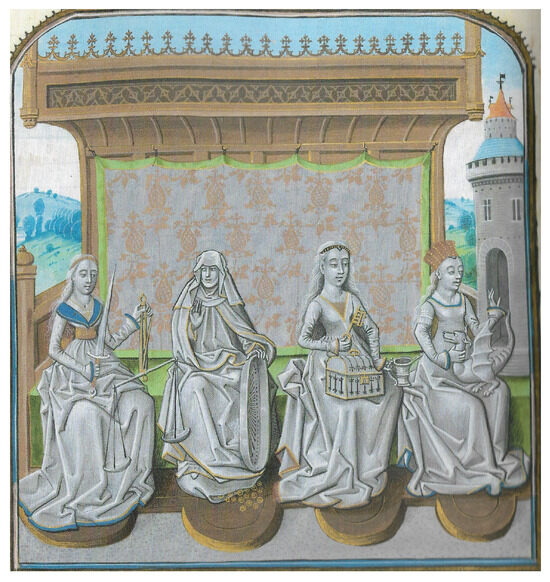
Figure 8.
Cardinal Virtues, La Sale, Antonio de la Sale, 1461, La Haya, Koninklijke Bibliotheek, ms. 9287–9288, fol. 113.
4. Attributes of Temperance Related to Chastity
Beyond “Chaste Temperance” iconographic types, there are some Temperance emblems related to chastity: a bit and/or bridles, the salamander, and the ermine.
4.1. Bit and Bridles
The bit has been an attribute of Temperance since the 9th century, as Theodulf of Orléans described Moderation carrying a frena and flagella (bit and whip) (North 1979, p. 217). However, bridles were already related to Temperance in Antiquity. In Plato’s Phaedrus, Modesty produces the use of reins: “whom he beholds in company with modesty like an image upon a holy pedestal. He sees her, but he is afraid and falls backwards in adoration, and by his fall is compelled to pull back the reins with such violence as to bring both the steeds on their haunches”.22
Since the 14th century, the bit and bridles became one of the most common attributes in images of Temperance. These frequent attributes referred to some qualities of Temperance: abstinence, sobriety, and continence. However, since the 15th century, bit and bridles acquired a new meaning related to confrontation to pleasures, as biblical sources mention: “Do not follow your lusts, restrain your desires” (Si 18,30). For this reason, Fray Íñigo de Mendoza described Temperance as holding a bridle or bit, referring to touch’s contention facing pleasure:
“Labraran mas vna brida/desabrida/contra el carnal mouimiento,/por que no con desatiento/en vn momento/nos manzilla fama y vida;/sy la carne no es regida y sometida/al freno déla razón, / las espuelas de afición/en tal son le dan tal arremetida,/que es muy cierta su cayda./Sera de blanca color/por honor,/que es enemiga de amores,/y serán de sus lauores/bordadores/esquiuidad y temor;/y terna mas el amargor/que el dulçor/por guardar el freno sano,/y desdeñado lo vfano,/a punto llano/labraran esta lauor,/que es mas segura y mejor”.(Mendoza 1912, p. 76)
Therefore, bit and bridle are visual depictions of pleasures’ continence, specifically taste and touch. Fernán Pérez de Guzmán related this continence to the necessary fortitude that Temperance needs to face bodily temptations: “El mas sabio i esforçado/es el que los naturales/apetitos i carnales/ha vencido i sobrado;/este es el principal grado/de saber i fortaleza” (Pérez de Guzmán 1912, p. 615).
A century later, Cesare Ripa also described Temperance carrying a bit and bridles to explain Temperance’s goal to face bodily pleasures: “Dipingesi col freno in una mano, e col tempo nell’altra, per dimostrare l’offizio della Temperanza, che è raffrenare, e moderare gli appetite dell’animo” (Ripa 1765, vol. 5, p. 266). Ripa explains more about the kind of pleasures Temperance should avoid: “il freno dichiara, che deve essere la Temperanza principalmente adoperata nel gusto, e nel tattoo; l’uno de’ quali solo si partecipa per la bocca, e l’altro è steso per tutto il corpo” (Ripa 1765, vol. 5, p. 267).
When artists wanted to emphasize chastity in a Temperance image, they depicted bits and bridles. In Traité des vertus, de leur excellence, et comment on les peut acquérir (ca. 1510, París, Bibliothèque Nationale de France, fr. 12247, fol. 12r) (Figure 9a), Temperance constrains Cupid and Cupidinitas with strings to control them. Beyond Temperance’s enmity to them since Antiquity, Faroult explains that the depiction of Temperance was inspired by the images of vestal virgins because they were the perfect example of refrenatio cupiditatis (see Faroult 2006). Achille Bocchi in Symbolicarum quaestionum, de universo genere, quas serio ludebat, libri quinque (1574) (Figure 9b) depicted Temperance holding bridles to control Cupid.23 Cupid wears a bit because he spreads the love that leads people to bodily pleasures and Lust, the vice opposite of Temperance. Also, in the Viconti-Sforza Tarot (ca. 1432–1450), Bonifacio Bembo depicted Temperance and Fortitude accompanying the Lovers’ carriage, which Cupid attacks (Moakley 1966, p. 74). But in Bocchi’s emblem, Temperance holds another Cupid, who carries a torch. The Amoris divini et humani antipathia (1629) explains that Cupid spreads the flame of love: “presto se buelue a encender/si es recién muerta la llama/en el pecho, de quien ama” (Amoris 1629, p. 67) and “si se enciende bien amor/llueua el cielo, y moxe el mar/que nole podra matar” (Amoris 1629, p. 143).
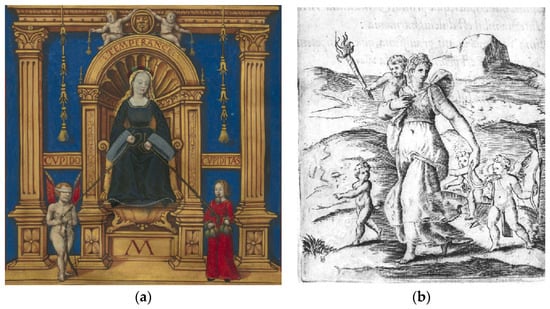
Figure 9.
(a) Temperance, Cupid, and Cupidinitas, Traité des vertus, de leur excellence, et comment on les peut acquérir, ca. 1510, París, Bibliothèque Nationale de France, fr. 12247, fol. 12r. (b) “Non est amicus hic, qui amare desinit”, Symbolicarum quaestionum, de universo genere, quas serio ludebat, libri quinque, 1574, London, Warburg Institute, II, simb. XLVI.
4.2. Salamander and Ermine
Although “Chaste Temperance 1” tried to extinguish Cupid’s fire, this virtue agrees with spiritual love. North explains that the salamander refers to resistance to passion because it can live uninjured among flames (North 1979, p. 182). The medieval Bestario Toscano explained about this concept:
“De la salamandra, que vive de fuego, podemos conocer dos clases de hombres: una, son todos aquellos que están inflamados por el amor del Espíritu Santo, así como Nuestro Señor inflamó a los Apóstoles del Espíritu Santo, en forma de lenguas de fuego, el día de Pentecostés; (…) La otra clase, son todos aquellos que son lujuriosos y ardientes del amor carnal”.(Sebastián 1984, p. 26)
So, salamanders are able to live while surrounded by fire. Temperance is soaked in God’s fire, but it does not allow burning by bodily love’s fire because chastity and virginity are its qualities. Pliny the Elder in Natural History (10, 67) explains that a salamander is so cold that it can even extinguish a fire, like Temperance extinguishes it by pouring water. Camillo Camilli’s emblem “Intvs ad omnem” explains: “salamandra non è animale di quei, che nascono nel fuoco, quali sono i Pirigoni: ma è bene tanto ardita, che gli và incontro, & affrontando la sua fiamma, come suo certo nimico, si sforza in tal modo si spegnerla” (Camilli 1586, vol. I, p. 131). Joachim Camerius’s emblem “Candide et syncere”24 and Silvestro Pietrasanta’s emblem “Dvrabo” (Pietrasanta 1634, p. 262) explain similar qualities of the salamander. So, the salamander defeats fire as Temperance defeats bodily pleasures. Paolo Giovio25 and Cesare Capaccio26 explained that a salamander could extinguish the fire in the emblem “Nvtrisco et extingvo”. In addition, Horapolo explains that “to write ‘purity’, they depict fire and water because these elements are necessary to carry out a purification” (Horapolo 1991, p. 125). Purity is a quality of Temperance, as well as Chastity and Virginity. Although a salamander is not a very common attribute, Heinrich Aldegrever (1552) (Figure 10a) depicted Temperance near an emblem of this animal.
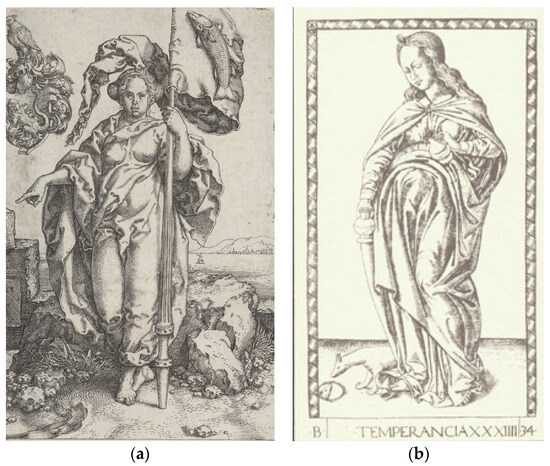
Figure 10.
(a) Temperance, The Virtues, Heinrich Aldegrever, 1552; (b) Temperance, Mantegna’s Tarot, 15th century.
More frequent is the ermine as Temperance’s attribute, as in Mantegna’s Tarot (15th century) (Figure 10b). This animal refers to purity and chastity, which are Temperance’s qualities. The ermine was already considered a tempered animal in the 14th century, as Flor de Virtudes explained: “Enxemplo. Esta virtud se puede comparar al erminyo, que es un animal tan cortés, tan comedido e gentil como sea en el mundo, de manera que por la su grande temperancia e natural gentileza, no come jamás sino una vez al día, e no comería ratones o cosa alguna que fuesse suzia” (Hurus 2013, p. 138). León Coloma (1998, p. 222) refers to the ermine as an emblem of purity because it loves the whiteness of its coat. Cervantes in El Quijote (I, 33) compared the ermine with a chaste woman, and Giovio’s emblem “Malo mori qvam foedari”27 explains a similar idea. A portrait of Elizabeth Queen of England (1773, Glasgow, Hunterian Museum) shows the queen near a column which has an ermine on top of it, an emblem of the chastity and temperance that characterized her. In addition, in The Seven Virtues, Jacopo Strada (1572, Milán, Gabinetto delle Stampe) depicted Temperance holding bridles, and there is an ermine at its feet.
5. Conclusions
The enmity between Temperance and lust comes from Antiquity written sources. This idea remained during the Middle Ages and Early Modern Era and influenced its depictions. This enmity was depicted in two iconographic types. In “Chaste Temperance 1”, this virtue pours water on a fire’s torch, and in “Chaste Temperance 2”, it tries to open/close a castle with one or two keys. These iconographic types reinforce Temperance’s qualities of chastity and virginity. In addition, bits and bridles are Temperance’s attributes that reinforce its enmity to lust. Moreover, the salamander and ermine are emblems of Temperance because they emphasize their uncorrupted purity. So, when someone wanted to emphasize Temperance’s qualities, these attributes were depicted in its allegory or emblem. These attributes emphasize chastity in Temperance depictions because the ideal of body pureness was a constant for Christianism during the Middle Ages (Montesinos 2019, p. 133). However, images had to be analyzed from an iconological perspective to interpret their purposes in any determined context. This essay only focused on iconographical aspects, which explain the origins and meaning of these depictions of written sources. This research provides readers with the basis to explain these images beyond the Iconologia (1593; Ripa 1765) by Cesare Ripa. Usually, art historians try to explain all kinds of allegories by reading these sources, but allegorical treatises do not include all ways to depict every concept, as in Temperance’s case. Therefore, to understand depictions of Temperance, it is necessary to relate them to written sources. Knowing that chastity, purity, and virginity are Temperance’s qualities is essential for better comprehending the images’ origin and meaning. After an iconographical analysis, it will be easier to engage in future research about these artworks from an iconological approach by studying them in the specific context in which they were created.
Funding
Generalitat Valenciana: Atracció del talent INV17-01-13-01; Ministerio de Ciencia e Innovación, Gobierno de España (PID2019-110457GB-100).
Institutional Review Board Statement
Not applicable.
Informed Consent Statement
Not applicable.
Data Availability Statement
No new data were created or analyzed in this study. Data sharing is not applicable to this article.
Conflicts of Interest
The author declares no conflict of interest.
Notes
| 1 | An iconographic type is the visual concretion of a topic. (García Mahíques 2009, p. 348). See (Montesinos Castañeda 2020). |
| 2 | From the 15th century, Virtues’ depictions were different in French art, which spread to Flemish and Spanish lands (Montesinos Castañeda 2022). |
| 3 | “Iconography”refers to an analytic description and classification of images. It is important not confusing this term with “iconology”, which refers to an analytical process to interpret visual artworks from the context in which they were created (García Mahíques 2009, p. 343). |
| 4 | Author translation. |
| 5 | See note 4 above. |
| 6 | Translation from: https://www.poetryintranslation.com/PITBR/Latin/TheGoldenAssV.php#anchor_Toc348436733 (accessed on 27 August 2023). |
| 7 | Translation from: https://www.poetryintranslation.com/PITBR/Latin/Metamorph10.php#anchor_Toc64105567 (accessed on 21 October 2023). |
| 8 | “temperantiae omnia relinquere, in quantum natura patitur, quae corporis usus requirit” (Macrobius 1952, 121; somn. 1,8,4). |
| 9 | “temperantia sequuntur modestia, verecundia, abstinentia, castitas, honestas, moderatio, parcitas, sobrietas, pudicitia” (Macrobius 1952, 121; somn. 1,8,7). |
| 10 | According to Alain de Lille Temperance’s virtues or qualities are: Continence, Chastity, Purity, Sobriety, Parsimony, Moderation, Honestity, Abstinence, Shame and Modesty (Delhaye 1963, p. 16). |
| 11 | “Ed udasi questa virtú per molte vie, ed ha catuna il suo nome per meglio averle a memoria. E quelle sono le virtú che nascono di Temperanza, e sono cosí appellate: Castità, Pudicizia, Astinenzia, Larghezza, Parcità, Umilità, Onestà, Vergogna” (Giamboni 1968, p. 9). |
| 12 | “discretio, morigeratio, taciturnitas, jejunium, sobrietas, afflictio carnis, contemptus saeculi” (Hugh of de St Víctor, De fructibus carnis et spiritus, 15; PL CLXXVI, 1003). |
| 13 | “Est autem temperantia circa delectationes tactus, quae dividuntur in duo genera. Nam quaedam ordinantur ad nutrimentum. Et in his, quantum ad cibum, est abstinentia; quantum autem ad potum, proprie sobrietas. Quaedam vero ordinantur ad vim generativam. Et in his, quantum ad delectationem principalem ipsius coitus, est castitas; quantum autem ad delectationes circumstantes, puta quae sunt in osculis, tactibus et amplexibus, attenditur pudicitia” [Other pleasures are directed to the power of procreation, and in these as regards the principal pleasure of the act itself of procreation, there is “chastity”, and as to the pleasures incidental to the act, resulting, for instance, from kissing, touching, or fondling, we have “purity”] (Aquinas 2017; S.Th. [44719] IIª-IIae, q. 143 co.). Translation from: https://www.newadvent.org/summa/3143.htm (accessed on 27 August 2023). |
| 14 | “Temperanza è la quarta virtú principale che nasce all’uomo e alla femina della buona volontà, per la quale si concia e ordina l’animo dell’uomo a rifrenare i desiderî della carne, laonde l’uomo è assalito e tentato” (Giamboni 1968, p. 9). |
| 15 | “The name of the second seed was ‘the Spirit of Temperance’. Whoever fed off this seed acquired a temperament of such a kind that he never ended up swollen, wether from over-eating or from stress. No mockery or insult could disturb his self-control; nor could an increase in his fortune, brought about by his success in trade. He would never allow himself to be upset by words thrown out in idle thoughtlessness. Nor would he ever let a suit of clothes artfully tailored and cut be seen on his back, nor spicy food from the hand of a master-chef diffuse its choice flavors on his palate” (Quoted by Tucker 2015, p. 164). |
| 16 | “Tempaerantia quippe quarta species virtutis est rationabilis in libidinem, atque in alios non rectos animi firma et moderata dominatio” (Rabano Mauro, De ecclesiastica disciplina, 3; PL CXII, 1255). “Temperantia est totius vitae modus, ne quid nimis homo vel amet, vel odio habeat, sed omnis vitae hujus varietates considerata temperet diligentia” (Halitgarius, De poenitentia 2,10; PL CV, 676). “Temperantia est dominium rationis in libidinem et in alios motus importunos” (Hildebert de Lavardin, Moralis philosophia, 36; PL CLXXI, 1034). |
| 17 | A literary image is which is composed by linguistic tools, such as a description, a metaphore or a poem (García Mahíques 2009, p. 344). |
| 18 | For more information about classical sources and Prudentius’ Psychomachia see: (Filosini 2022, pp. 9–37). |
| 19 | Other Cardinal Virtues have direct visual precedents, such as Athena/Minerva to Prudence, Heracles to Fortitude, Nemesis, Astrea, Maat or Shamash—among others—to Justice. |
| 20 | Camelliti’s paper is about Temperance’s depiction in Palazzo Minerbi-dal Sale in Ferrara (See Camelliti 2013). |
| 21 | Serafino Serafini’s Augustine of Hippo’s Triumph (ca. 1378, Pinacoteca Nazionale, Ferrara) and many 14th-century manuscripts show similar depictions. For instance: Lectura super Digesto novo de Bartoli de Sassoferrano, Madrid, Biblioteca Nacional, ms. 197, fol. 3r; Regia Carmina, Florencia, Bibliloteca Nazionale Centrale, Banco Rari 38, fol. 31v; Libro di Giusto, Roma, Galleria Nazionale, Gabinetto delle Stampe, inv. 2818–2833, fol. 4r. |
| 22 | Translation from: https://classics.mit.edu/Plato/phaedrus.html (accessed on 23 October 2023). |
| 23 | “Nescio cuius id est verbum sapientis iniquum,/tanquàm osurus ama. Quin ego amare velim/ut nunquam osurus. Nam quae vera, aut bona tándem/In vita reliqua est, dic mihi, amicitia?/Si quisque, olim ita amicum amet, ut fieri ipsum inimicum/posse putet? Virtusne ista rogo, an vitium est?/Quin ego non tanquàm: sed nunquam, osurus amabo./Vera sibi constat Semper amicitia” (Bocchi 1574, pp. 100–1; II, symb. XLVI). |
| 24 | “Eam non tantum non consumi igne, sed flamman etiam extinguere rigore suo” (Camerarius 1677, p. 138; IV, emb. 69). |
| 25 | “la Salamandra, che stando nelle fiamme, non si consuma, col motto Italiano, che diceva: NVTRISCO ESTIGVO, essendo propia qualità di quello animale, spargere dal corpo suo freddo humore sopra le bragie, onde avviene, ch’egli non teme la forza del fuoco, ma più tosto lo tempera e spegne” (Giovio 1559, p. 23). |
| 26 | “Della Salamandra (…) NVTRISCO ET ESTINGVO. Altri dicono c’havea scritto, Nutrisco il buono & estinguo il reo, c’havrebbe havuto altro significato” (Capaccio 1592, I, fol. 60r). |
| 27 | “E per dichiarare questo suo generoso pensiero di clemenza, figurò vn’Armellino circondato da vn riparo di letame, con vn motto di sopra, MALO MORI, QVAM FOEDARI, essendo la propia natura dell’Armellino di patir prima la norte per fame e per sete, che imbrattarsi, cercando di fuggire, di non pasar per lo brutt, per non macchiare il candore e la pulitezza della sua pretiosa pelle” (Giovio 1559, p. 31). |
References
- Amoris. 1629. Amoris divini et humani antipathia. Anvuerpiae: Snyders. [Google Scholar]
- Apuleius. 1996. La Metamorfosis o El asno de oro. Translated by Carlos García Gual. Madrid: Gredos. [Google Scholar]
- Aquinas, Saint Thomas. 2017. Summa Teológica. Available online: https://www.newadvent.org/summa/3143.htm (accessed on 28 August 2023).
- Aristotle. 1868–1944. Aristotle: In Twenty-Three Volumes. Cambridge, MA: Harvard University Press.
- Aristotle. 1973. Obras. Edited by Francisco de P. Samaranch. Madrid: Aguilar. [Google Scholar]
- Bocchi, Achille. 1574. Symbolicarum quaestionum, de universo genere, quas serio ludebat, libri quinque. Boloniae: Societatem Typographiae Bononiensis. [Google Scholar]
- Boissard, Jacques. 1588. Emblematum Liber. Metz: Francoforti ad Moenum. [Google Scholar]
- Cacho, María Teresa. 1999. Los moldes de Pygmalión (sobre los tratados de educación femenina en el Siglo de Oro). In Breve historia feminista de la literatura española (en lengua castellana). Edited by Iris M. Zavala. Barcelona: Anthropos, pp. 177–214. [Google Scholar]
- Camelliti, Vittoria. 2013. La Temperanza di Palazzo Minerbi-dal Sale a Ferrara. Riflessioni sulla trasmissione di una tipología iconográfica. Rivista di storia della miniatura 17: 122–36. [Google Scholar]
- Camerarius, Joachim. 1677. Symbola et emblemata. Maguncia: Christophori Küstleri. [Google Scholar]
- Camilli, Camillo. 1586. Imprese illustri di diverse. Venecia: Francesco Ziletti. [Google Scholar]
- Capaccio, Giulio Cesare. 1592. Trattato delle imprese. Nápoles: Horatij Salviani. [Google Scholar]
- de la Perrière, Guillaume. 1545. Le théatre des bons engins. Paris: Denys Ianot. [Google Scholar]
- Delhaye, Philippe. 1963. La vertu et les vertus dans les oeuvres d’Alain de Lille. Cahiers de civilisation médiévale 6: 16. [Google Scholar] [CrossRef]
- di Bartoli, Bono. 1904. La Canzone delle Virtù e delle Scienze. Bérgamo: Ed. d’Arti Grafiche. [Google Scholar]
- Faroult, Guillaume. 2006. Les Fortunes de la Vertu. Origines et évolution de l’iconographie des vestales jusqu’au XVIIIe siècle. Revue de l’Art 152: 9–30. [Google Scholar]
- Filosini, Stefania. 2022. Ovidian Presences in Prudentius’ Psychomachia. In After Ovid: Aspects of the Reception of Ovid in Literature and Iconography. Edited by Franca Ela Consolino. Turnhout: Brepols Publishers, pp. 9–37. [Google Scholar] [CrossRef]
- García Mahíques, Rafael. 2009. Iconografiía e Iconología. Volumen 2. Cuestiones de método. Madrid: Encuentro. [Google Scholar]
- Giamboni, Bono. 1968. Il libro de’ vizî e delle virtudi e Il trattato di virtú e di vizî. Torino: G. Einaudi. [Google Scholar]
- Giovio, Paolo. 1559. Dell’imprese militari et amorose. Lyon: Guglielmo Roviglio. [Google Scholar]
- Horapolo. 1991. Hieroglyphica. Edited by José María González de Zárate. Madrid: Akal. [Google Scholar]
- Hurus, Juan or Pablo. 2013. Flor de Virtudes. Edited by A. Mateo Palacios. Zaragoza: Prensas de la Universidad de Zaragoza. [Google Scholar]
- Imperial, Francisco. 1977. El dezir a las syete virtudes y otros poemas. Madrid: Espasa-Calpe. [Google Scholar]
- Lacarra, María Eugenia. 1999. Representaciones femeninas en la poesía cortesana y en la narrativa sentimental del siglo XV. In Breve historia feminista de la literatura española (en lengua castellana). Edited by Iris M. Zavala. Barcelona: Anthropos, pp. 159–76. [Google Scholar]
- Lackey, Douglas P. 2005. Giotto in Padua: A New Geography of the Human Soul. The Journal of Ethics: An International Philosophical Review 9: 563. Available online: https://www.jstor.org/stable/25115841 (accessed on 27 August 2023).
- León Coloma, Miguel Ángel. 1998. Sobre la iconografía de la templanza. Cuadernos de arte de la Universidad de Granada 29: 213–28. Available online: https://revistaseug.ugr.es/index.php/caug/article/view/10398 (accessed on 27 August 2023).
- Macrobius. 1952. Commentary on the Dream of Scipio. New York: Columbia University Press. [Google Scholar]
- Mendoza, Fray Íñigo de. 1912. Vita Christi fecho por coplas por frey Yñigo de Mendoca a petiçion de la muy virtuosa señora doña Juana de Cartagena. In Cancionero castellano del siglo XV. Madrid: Bailly Bailliere. [Google Scholar]
- Moakley, Gertrude. 1966. The Tarot Cards Painted by Bonifacio Bembo for the Visconti-Sforza Family; An Iconographic and Historical Study. New York: New York Public Library. [Google Scholar]
- Montesinos, José Galiano. 2019. El matrimonio medieval. Entre la castidad y la familia. Paratge 32: 119–34. [Google Scholar]
- Montesinos Castañeda, María. 2020. Los fundamentos de la visualidad de la Templanza. Formación de su tipología iconográfica hasta el siglo XIV. De Medio Aevo 14: 161–75. [Google Scholar] [CrossRef]
- Montesinos Castañeda, María. 2022. El tipo iconográfico de la Templanza en la “nueva visualidad”. Eikón Imago 11: 273–85. [Google Scholar] [CrossRef]
- North, Helen. 1979. From Myth to Icon: Reflections of Greek Doctrine in Literature and Art. Ithaca: Cornell University Press. [Google Scholar]
- O’Reilly, Jennifer. 1988. Studies in the Iconography of the Virtues and Vices in the Middle Ages. New York: Garland Pub. [Google Scholar]
- Panofsky, Erwin. 1965. Renaissance and Renascences in Western Art. Stockholm: Almquist & Wiksells. [Google Scholar]
- Pérez de Guzmán, Fernán. 1912. Coblas fechas por Fernán Pérez de Guzman de vicios i virtudes. In Cancionero castellano del siglo XV. Madrid: Bailly Bailliére, vol. 1, p. 615. [Google Scholar]
- Pietrasanta, Silvestro. 1634. De Symbolis Heroicis. Antuerpiae: Balthasaris Moreti. [Google Scholar]
- Plato. 1949. República. Translated by José Manuel Pabón, and Manuel Fernández-Galiano. Madrid: Instituto de Estudios Políticos. [Google Scholar]
- Prudentius, Aurelius. 1949. Prudentius, with an English Translation by H.J. Thomson. London: Heinemann. [Google Scholar]
- Rademaker, Adriaan. 2004. Sophrosyne and the Rhetoric of Self-Restraint: Polysemy & Persuasive Use of an Ancient Greek Value Term. Leiden: Brill. [Google Scholar]
- Ripa, Cesare. 1765. Iconologia. Perugia: Piergiovanni Constantini, vols. 3 and 5. [Google Scholar]
- Sebastián, Santiago. 1984. El Fisiólogo. Translated by Francisco Tejada Vizuete. Madrid: Tuero. [Google Scholar]
- Timoneda, Juan. 1992. Romance de Perseo. In Romances de la Antigüedad Clásica. Edited by M. Cruz de Castro. Madrid: Ediciones Clásicas. [Google Scholar]
- Tucker, Shawn. 2015. The Virtues and the Vices in the Arts. Cambridge: The Lutterworth Press. [Google Scholar]
- White, Lynn. 1969. The Iconography of “Temperantia” and the virtuousness of technology. In Action and Conviction in Early Modern Europe: Essays in Memory of E.H. Harbinson. Princeton: Princeton University Press, pp. 197–219. [Google Scholar]
- White, Lynn. 1973. Tecnología medieval y cambio social. Buenos Aires: Paidós. [Google Scholar]
- Whitehead, Felicity. 1960. Oftermod et demesure. Cahiers de Civilisation Médiévale 3: 115–17. [Google Scholar]
Disclaimer/Publisher’s Note: The statements, opinions and data contained in all publications are solely those of the individual author(s) and contributor(s) and not of MDPI and/or the editor(s). MDPI and/or the editor(s) disclaim responsibility for any injury to people or property resulting from any ideas, methods, instructions or products referred to in the content. |
© 2023 by the author. Licensee MDPI, Basel, Switzerland. This article is an open access article distributed under the terms and conditions of the Creative Commons Attribution (CC BY) license (https://creativecommons.org/licenses/by/4.0/).